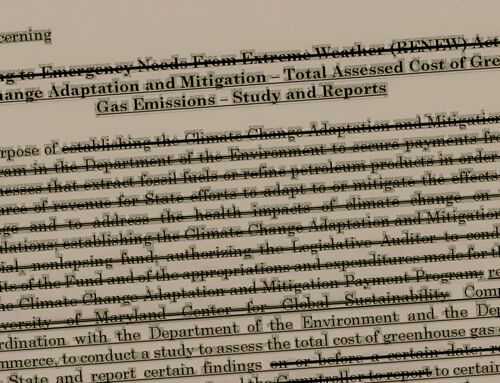View by Topic
Recent Articles
-
New Environmental Laws from the 2025 Maryland Legislative SessionSaturday, April 26th, 2025
-
Migratory Bird Treaty Act Does Not Prohibit Incidental Take – AgainSaturday, April 19th, 2025
-
President Trump’s Bold Step to Rein in State Overreach in Climate ChangeSaturday, April 12th, 2025
-
Mandatory GHG Disclosures in Maryland Real Estate ContractsSaturday, April 5th, 2025
View by Month/Year
“Green Building Law Update” Headlines
Recent Articles & News from
Stuart Kaplow’s blog
at GreenBuildingLawUpdate.com
- BEPS Redux: The Most Far Reaching Environmental Legislation of the 2025 Maryland General Assembly May 4, 2025
- New Environmental Laws from the 2025 Maryland General Assembly Session April 27, 2025
- Migratory Bird Treaty Act Does Not Prohibit Incidental Take – Again April 20, 2025
- President Trump’s Bold Step to Rein in State Overreach in Climate Change April 13, 2025
Subscribe to the Green Building Law Update!
Stuart Kaplow brings his expertise and extensive experience to the table with his unique digital publication, "Green Building Law Update". Subscribers receive regular updates to keep them informed about important issues surrounding Environmental Law, Green Building & Real Estate Law, as well as the emerging demand for Environmental Social Governance (ESG).
Get fresh content through the lense of Stuart Kaplow's cutting-edge expertise, innovative commentary and insider perspective. Don't miss another issue! Subscribe below.

Rising Demand for Man Made Diamonds is ESG Personified
For centuries, diamonds have been coveted for their rarity, beauty, and as a status symbol. However, the diamond jewelry industry has been plagued with controversy over the years, including issues related to environmental impact, human rights violations, and questionable business practices. As a result, in recent years, man made diamonds have emerged as a popular alternative to mined from the earth diamonds.
And this may be particularly relevant this year, 2023, when for the first time the global diamond market will be worth more than $100 Billion.
The Knot wedding website surveyed nearly 12,000 couples married in 2022 and more than 36% of center stones in engagement rings were man made, literally doubling in popularity in the past two years (i.e., increasing more than 18% since 2020).
To buttress that trend, it is reported in 2022 man made diamonds accounted for 13.6% of total diamond jewelry sales up from less than 1% of jewelry in 2015. The reasons for that surge are several:
Firstly, one of the biggest advantages of gem quality synthetic diamonds made by man is their significantly lower environmental impact compared to dinosaur age diamonds mined from the earth. The process of diamond mining involves extensive land excavation, energy consumption, and water usage, which can lead to soil erosion, water pollution, and other environmental degradation. In contrast, man made diamonds are created in a laboratory type setting increasingly using renewable energy sources and recycled materials, which literally and figuratively significantly reduce their carbon footprint. Diamonds are pure carbon and mined diamonds take millions of years of exposure to pressure and heat to form (.. although some suggest more than 1 billion years), at a time when we are supposed to be decarbonizing society, whereas man made diamonds take about 600 hours to grow each carat. As a result, the solid form of the element of carbon with its atoms arranged in a crystal structure by man in a diamond cubic is considered by many the environmentally sustainable choice that aligns with ESG principles.
Secondly, the social impact of diamond mining has been a major concern for many years, with reports of child labor, forced labor, and human rights abuses in the industry. By opting for man made diamonds, consumers can ensure that their jewelry is free from such ethical concerns. Man made diamonds are produced in a controlled environment without the involvement of any labor exploitation, ensuring ethical and fair labor practices. This makes them a socially responsible choice that aligns with ESG principles.
Thirdly, the corporate governance practices of companies that produce and sell diamonds have also come under scrutiny in recent years. The diamond industry is suggested to be opaque and lacking transparency, which can make it difficult for consumers to know whether their jewelry has been ethically sourced. Despite that the Clean Diamond Trade Act, signed into law on July 29, 2003, prohibits the “importation into, or exportation from, the U.S. of any rough diamond, from whatever source, unless the rough diamond has been controlled through the Kimberley Process Certification Scheme,” the concern persists over “conflict diamonds,” defined as diamonds used by rebel movements to finance military action opposed to legitimate governments. This makes man made diamonds a choice that aligns with ESG principles and can help promote good corporate governance.
Additionally, the cost of producing manmade diamonds has decreased dramatically, making them more affordable than their mined counterparts. Today a man made 1 carat diamond might retail for $1,430 compared to $5,635 for a similar stone mined from the ground. Accordingly, market data bears out that man made diamonds have become astoundingly more popular in a short time, especially among younger consumers who are more conscious about sustainability and ethical practices and after they make their engagement ring purchase (often their first diamond) they will be more likely to make similar man made jewelry purchases in the future, something particularly damning for the legacy diamond industry.
Another reason why man made diamonds are becoming more popular, including among the jewelry trades (itself a key sector of the diamond industrial complex) is that those stones caused by human beings offer greater design flexibility. Mined diamonds are limited in size, shape, and color, whereas man-made diamonds can be created in a variety of shapes, sizes, and colors, offering greater customization options for jewelry designers (.. think a stone fitting in a watch face).
Finally, after overreaching by the Federal Trade Commission which took several steps beginning in 2018, including in its Jewelry Guides, to alter the many facets of advertising man made diamonds with clarity despite that they have the same chemical composition and physical properties, the agency has now shifted its focus on other industries. In fact, increasing numbers of high end jewelers are even using man made diamonds in their designs, including in watches, proving that they are just as valuable as mined diamonds.
The FTC appeared to be confused if not blinded by the instance of cubic zirconia which is the crystalline form of zirconium dioxide, or the agency thought consumers were confused, but those stones are not a diamond and at best might be a simulated stone or imitation diamond; and certainly not what is being described here. It is troubling when government prohibits the use of true statements of fact when an agency unilaterally deems them unfair or deceptive.
And it should also be noted that all of this does not even consider the multi Billion dollar industrial diamond market that today is almost exclusively man made and is key where diamonds have the highest hardness and thermal conductivity of any naturally occurring material.
Diamonds made by man are replacing dinosaur age diamonds mined from the earth for a host of reasons, including their lower environmental impact, ethical labor practices, affordability, design flexibility, and comparable quality. As more consumers become aware of the ESG associated advantages of diamonds caused by human beings, it is all but certain their popularity will continue to grow, making them a preferable alternative to legacy mined diamonds in the more than $100 Billion diamond market and the impact will be felt far beyond only diamonds as these same ESG factors are applied by stakeholders in other transactions.
And if human beings can geoengineer carbon rich deposits into diamonds why not geoengineer that same carbon into fossil fuel for energy, .. just asking?
A live webinar “Do You Own Your GHG Emission Data,” 30 talking points in 30 minutes, Tuesday, May 23 at 9 am EST presented by Stuart Kaplow and Nancy Hudes on behalf of ESG Legal Solutions, LLC. The webinar is complimentary, but you must register here.









